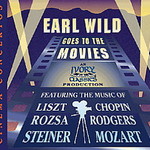
Earl Wild Goes to the Movies (Incls Mozart' Piano Concerto No 21 & Slaughter on 10th Avenue)
 $35.00
Special Order
$35.00
Special Order3 - 6 weeks add to cart
VARIOUS COMPOSERS
Earl Wild Goes to the Movies (Incls Mozart' Piano Concerto No 21 & Slaughter on 10th Avenue)
Earl Wild (piano) / London Promenade / RCA Symphony / Royal Philharmonic Orchestra
[ Ivory Classics / CD ]
Release Date: Saturday 26 January 2008
This item is only available to us via Special Order. We should be able to get it to you in 3 - 6 weeks from when you order it.
Born on November 26, 1915 in Pittsburgh, Pennsylvania, the young Wild displayed extraordinary musical ability from the age of three. By the time he was six years of age, he was reading music fluently and before his twelfth birthday, he was studying with the famous teacher, Selmar Janson.
Earl Wild was then placed into a programme for artistically gifted young people at Pittsburgh's Carnegie Tech (now Carnegie Mellon University).
Still in his early teens, Wild began playing piano and celeste in the Pittsburgh Symphony Orchestra under the baton of Otto Klemperer and by the age of nineteen, was already a concert hall veteran and had composed many piano transcriptions as well as arrangements for chamber orchestra that were often performed on local radio stations. He was also invited to perform on the radio station KDKA in Pittsburgh (the first radio station in the United States) and made such an impression that he began working there on a regular basis.
During this early period of his career, Earl Wild gave a brilliant and critically well received performance of the Liszt E Flat Piano Concerto with Dimitri Mitropoulos and the Minneapolis Symphony in Pittsburgh's Syria Mosque, without the benefit of a rehearsal!
In 1937, Wild joined the NBC network as staff pianist as well as performing in the NBC Symphony Orchestra under Toscanini. He became the first artist to perform a piano recital on US television and in 1942, became a household name when Toscanini invited him to be the soloist in Gershwin's Rhapsody in Blue, the first performance of the Rhapsody for both conductor and soloist. Wild was immediately hailed as the major interpreter of Gershwin, the youngest piano soloist ever engaged by the NBC Symphony.
During World War II, Earl Wild served in the United States Navy as a musician, playing flute in the Navy Band, as well as performing solo piano recitals at the White House and numerous piano concertos with the U.S.
Navy Symphony Orchestra at the Departmental Auditorium and other venues in Washington, D.C. During these two years in the Navy he was frequently requested to accompany First Lady Eleanor Roosevelt to her many speaking engagements, performing the National Anthem as a prelude to her speeches.
Upon leaving the Navy in 1945, he moved to the newly formed American Broadcasting Company (ABC), where he remained as staff pianist, conductor and composer until 1968. At the time of his NBC and ABC affiliation, he was also performing many concert engagements around the world. At ABC he conducted and performed many of his own compositions and in 1962, ABC commissioned him to compose an Easter Oratorio. It was the first time that a television network subsidized a major musical work. Earl Wild was assisted by tenor William Lewis, who wrote the libretto and sang the role of St. John in the production. Revelations was a religious work based on the apocalyptic visions of St. John the Divine. Wild also conducted it's world premiere telecast in 1962 which blended dance, music, song and theatrical staging. The first telecast of this large-scale oratorio was so successful that it was entirely re-staged and re-broadcast in 1964.
Another composition entitled The Turquoise Horse was commissioned by Earl Wild, for the official opening and dedication ceremonies of the Palm Springs Desert Musieum's Annenberg Theater on January 11th 1976.
Tracks:
Rodgers/Earl Wild - Slaughter on 10th Ave.
Max Steiner - Symphonie Moderne
Liszt - Un Sospiro
Miklos Rozsa - Spellbound Concerto
Chopin - Grande Polonaise Brilliante, Op.22
Mozart: Piano Concerto No 21 in C major, K. 467